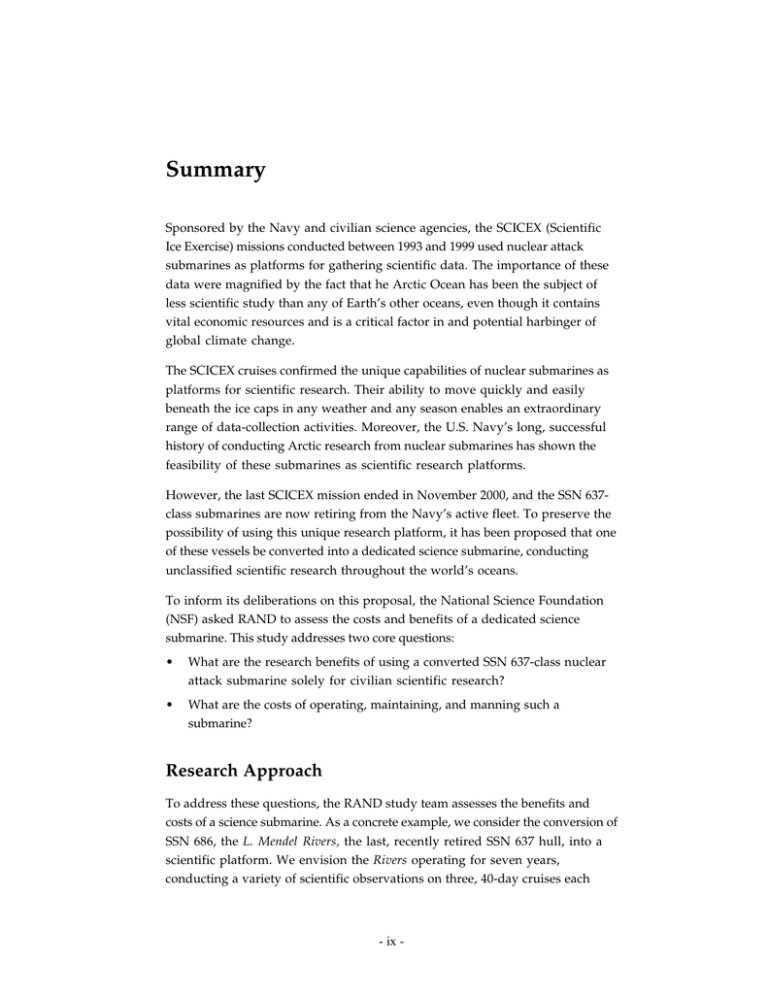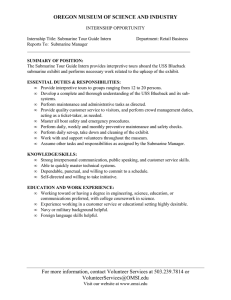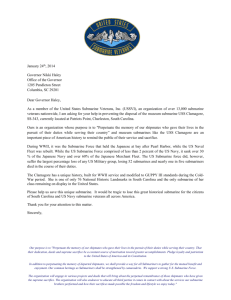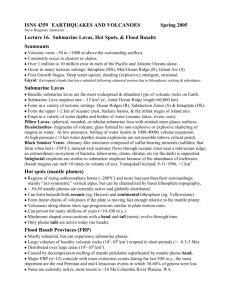Summary
advertisement

Summary Sponsored by the Navy and civilian science agencies, the SCICEX (Scientific Ice Exercise) missions conducted between 1993 and 1999 used nuclear attack submarines as platforms for gathering scientific data. The importance of these data were magnified by the fact that he Arctic Ocean has been the subject of less scientific study than any of Earth’s other oceans, even though it contains vital economic resources and is a critical factor in and potential harbinger of global climate change. The SCICEX cruises confirmed the unique capabilities of nuclear submarines as platforms for scientific research. Their ability to move quickly and easily beneath the ice caps in any weather and any season enables an extraordinary range of data-collection activities. Moreover, the U.S. Navy’s long, successful history of conducting Arctic research from nuclear submarines has shown the feasibility of these submarines as scientific research platforms. However, the last SCICEX mission ended in November 2000, and the SSN 637class submarines are now retiring from the Navy’s active fleet. To preserve the possibility of using this unique research platform, it has been proposed that one of these vessels be converted into a dedicated science submarine, conducting unclassified scientific research throughout the world’s oceans. To inform its deliberations on this proposal, the National Science Foundation (NSF) asked RAND to assess the costs and benefits of a dedicated science submarine. This study addresses two core questions: • What are the research benefits of using a converted SSN 637-class nuclear attack submarine solely for civilian scientific research? • What are the costs of operating, maintaining, and manning such a submarine? Research Approach To address these questions, the RAND study team assesses the benefits and costs of a science submarine. As a concrete example, we consider the conversion of SSN 686, the L. Mendel Rivers, the last, recently retired SSN 637 hull, into a scientific platform. We envision the Rivers operating for seven years, conducting a variety of scientific observations on three, 40-day cruises each - ix - year. Each cruise would follow a course determined by scientific requirements and carry 15 scientific researchers on board. We estimate the benefits of such a science submarine with qualitative assessments of its potential contributions to high-priority national research goals as identified by the scientific community. These goals fall in the topic areas of Geologic and Geophysical Exploration in the Arctic Basin, Arctic Climate Change, the Dynamics of Bering Sea Ecosystems, and general Oceanographic Studies in the Ice-Free Oceans. We focus on the unique contributions of a science submarine, that is, the benefits gained by adding a submarine to the existing portfolio of research platforms for the Arctic. These platforms include surface ships, icebreakers, satellites, autonomous underwater vehicles (AUVs), ice camps, airplanes, remote buoys, and instrumentation for acoustic propagation measurements. We first identify the unique measurements that could be provided by a submarine. We then place these measurements in a framework that relates measurements to the high-priority research goals they address. We choose this approach as a means to address the notoriously hard problem of estimating the benefits from scientific research. This approach to benefits assessment is consistent with NSF’s common assessment of large research facilities, but addresses the exceptionally interdisciplinary quality of submarine data. We then estimate the costs to convert, maintain, and operate a dedicated science submarine by starting with extensive Navy data on the comparable costs of a military submarine. We then develop a variety of cost scenarios, making different assumptions about how these costs might be reduced for scientific operations. Scientific Benefits We find that the most important contribution of a dedicated science submarine would be its ability to collect survey data in ice-covered seas. With its ability to navigate freely during all seasons and in all weather, a submarine is unmatched in its capability to collect large amounts of bathymetric or hydrographic data over the Arctic Basin, especially in the winter. A submarine also has unique capabilities to collect controlled seismic refraction and reflection surveys. Such data directly support the geological and geophysical exploration of the Arctic Ocean Basin. A dedicated science submarine could also make unique contributions to understanding climate change in the Arctic and its relationship to global climate change. For climate change research, the most important feature of the -x- submarine is the capability to collect data over broad areas of the Arctic Basin at all times of year. Of particular importance are hydrographic measurements in the upper ocean (temperature/salinity profiles), detailed mapping of ice draft and structure, and high-resolution bathymetric surveys. The science submarine could also uniquely contribute to understanding Bering Sea ecosystems. The submarine has a unique capability to make hydrographic and ice draft measurements under the ice in those regions of the Bering Sea where the water is sufficiently deep for safe operations and can also make unique contributions by monitoring biological features, such as water sampling from specific oceanographic features and mapping fish and zooplankton populations using the submarine’s sonar systems, in ice-covered seas. In the ice-free oceans, the submarine has fewer unique capabilities relative to surface ships, satellites, and drifting buoys. Without the limitations of an ice cover, ships have greater navigational capabilities, satellites can image a range of ocean properties over vast areas, and buoys can drift great distances. Under these circumstances, the submarine’s primary strength centers on data gathering in remote regions, rough seas, and bad weather. Our analysis focuses on the benefits of a dedicated science submarine in relation to the proven, current capabilities of other research platforms. We note, however, that autonomous underwater vehicles (AUV) technology is improving rapidly and could possibly equal or surpass many of the submarine’s unique measurement capabilities over the course of roughly a decade. Costs The total cost of operating and maintaining the L. Mendel Rivers as a dedicated science submarine could range from roughly $200 million to $300 million over an expected seven years of operation. Approximately $95 million to $125 million would be required for depot overhaul and science conversion, $20 million to $38 million for depot maintenance, $37 million to $55 million for operations including the cost of a Navy crew and consumables, and approximately $60 million for science support. The wide variation of potential costs is largely due to varying assumptions about whether the submarine could be overhauled and maintained at public or private shipyards, the allocation of overhead, and cost sharing between NSF and the Navy. These issues would likely be resolved and the cost made clearer if and when the government begins serious planning for a dedicated science submarine. The average annual cost of the submarine would range from $30 million to $40 million per year. By - xi - comparison, current NSF funding for Arctic research, logistics, and facilities support totaled approximately $70 million in fiscal year (FY) 2000. The cost of the submarine is unevenly distributed over time. The initial overhaul and science conversion of the existing vessel constitutes more than a third of the total lifetime costs of the science submarine. Thus in any scenario, the majority of spending would occur in the first years of the program, and hence there is little flexibility to reduce costs by focusing the dedicated science submarine on a few high-priority missions. Assessment A dedicated science submarine could make unique and important contributions to the priority research areas of Geologic and Geophysical Exploration of the Arctic Basin and Arctic Climate Change. It could make unique, important, though relatively lesser contributions to the priority research areas of the Bering Sea Ecosystem and General Oceanographic Studies in the Ice-Free Oceans. Maintaining and operating a science submarine could cost $200 million to $300 million over seven years of operations. Many uncertainties remain over the extent of these benefits and costs. For instance, the submarine could have nonscientific benefits not considered in this study; or technological advances could produce autonomous underwater vehicles that in a decade or more could obtain some of the measurements currently available only from a dedicated science submarine. Nonetheless, this report lays a foundation for decisionmaking on the deployment of such a research platform. Specifically we identify the priority research areas that would benefit most from the unique capabilities of a dedicated science submarine. Policymakers can assess the importance of these benefits in light of the costs we have identified. - xii -





